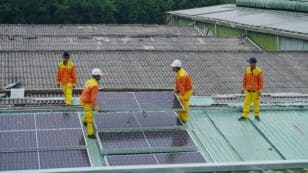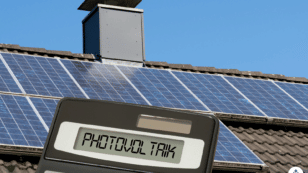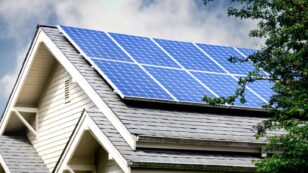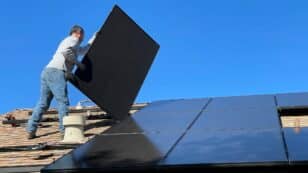
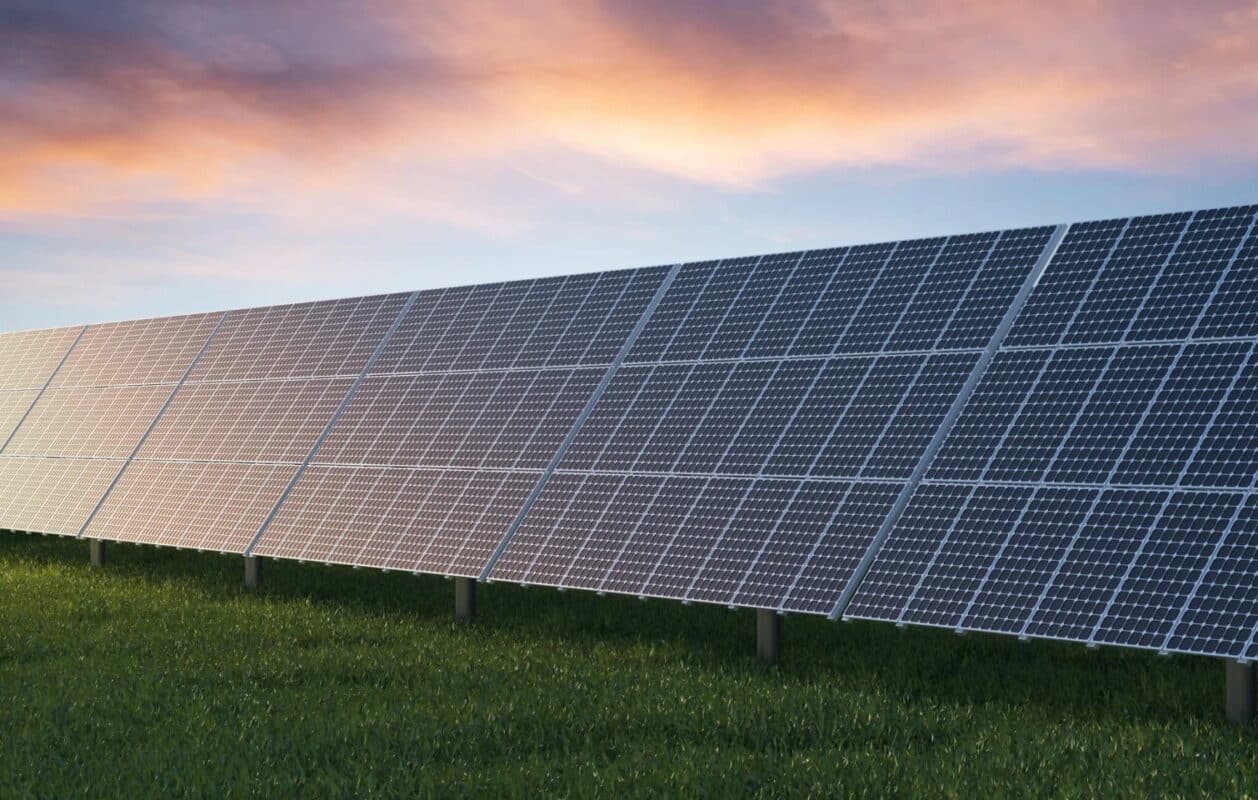
Monocrystalline Vs. Polycrystalline Solar Panels (What’s Best?)
Here’s what we’ll cover in this guide:
- Are monocrystalline better than polycrystalline panels?
- How and when to use monocrystalline vs. polycrystalline panels?
- What is each type of panel is made of and why?
Each product and or company featured here has been independently selected by the writer. You can learn more about our review methodology here. If you make a purchase using the links included, we may earn commission.
What are Monocrystalline and Polycrystalline Solar Panels?
Monocrystalline and polycrystalline solar panels are the two most common types of solar energy receptors. Both work using photovoltaic cells made of silicon — the same material that’s used in chips for electronic gadgets. The difference between monocrystalline vs. polycrystalline solar cells is the configuration of the silicon:
- Monocrystalline solar panels: Each solar PV cell is made of a single silicon crystal. These are sometimes referred to as “mono solar panels.”
- Polycrystalline solar panels: Each PV cell is made of multiple silicon crystal fragments that are melded together during manufacturing. You may see them called “multi-crystalline panels” or “poly panels.”
Both types of solar panels have the same purpose: converting sunlight into electricity. However, the crystalline silicon structure of individual solar cells affects their performance and appearance. In fact, you can identify the type of panel by simply observing the shape and color of its solar cells.
So which type of solar panel, monocrystalline or polycrystalline is better?
Truly it depends on what you are looking for in a solar panel but in our experience monocrystalline solar panels are better because they boast higher efficiency ranges and better power capacity. They also tend to be more widely available solar panel type when looking at best solar panel brands and options.

SunPower

Nationwide Service
Average cost
Pros
- Most efficient panels on the market
- National coverage
- Cradle to Cradle sustainability certification
- Great warranty coverage
Cons
- Expensive
- Customer service varies by local dealer
SunPower designs and installs industry-leading residential solar and storage solutions across all 50 states. With a storied history of innovation dating back to 1985, no other company on this list can match SunPower’s experience and expertise.
SunPower earns its position as the top national installer on our list for a handful of reasons: It installs the most efficient solar technology on the residential market, offers the most expansive service area and backs its installations with a warranty well above the industry standard. All the while, SunPower pioneers sustainability efforts within the industry.
If that weren’t enough, SunPower systems come packaged with products all manufactured in-house by its sister company, Maxeon. This means that your panels, solar cells, inverters, battery and EV chargers are designed to work together and are all covered under the same warranty.
SunPower’s biggest downside? Its high-efficiency panels are considerably more expensive than most of its competitors’ products. However, its powerful panels are workhorses that make up for the initial cost with more backend production (think about this like spending more money for a car that gets more miles per gallon).
Facts and Figures: SunPower
| EcoWatch Rating |
|---|
| Better Business Bureau (BBB) Rating |
| Year Founded |
| Average Cost ($-$$$$$) |
| Solar Services |
| Brands of Solar Equipment Offered |
| Warranty Coverage |
| 5 |
| A+ |
| 1985 |
| $$$$ |
| Solar Panels, Solar Batteries, EV Chargers, System Monitoring |
| SunPower Panels |
| 25-year all-inclusive warranty |

Blue Raven Solar

Regional Service
Average cost
Pros
- Industry-leading in-house financing
- Competitive pricing
- Excellent reputation
Cons
- Doesn't offer solar batteries (coming 2022)
We like Blue Raven Solar because it understands that, for most homeowners, the cost of solar presents the biggest barrier to entry.
For that reason, Blue Raven Solar developed an innovative solar financing plan that offers in-house, flexible, zero-money-down options. The results speak for themselves, as Blue Raven Solar is now one of the fastest-growing solar companies in the nation and was recently acquired by SunPower. Its BluePower Plus+ plan (exclusive to Blue Raven) mimics the flexible structure of a lease while still providing the greatest benefits of owning your system.
Eligible homeowners enjoy 18 months of solar power before having to pay their first bill. When coupled with the federal solar investment tax credit (ITC), the initial energy savings can offset more than a third of the overall cost of a system before requiring a dollar down.
In contrast, other installers can only offer similar financing through solar leases, PPAs or third-party providers (such as Mosaic or Sunlight). Third-party loan providers can complicate the process, while opting for a loan or PPA will disqualify you from some of solar’s biggest benefits (additional property value, federal solar tax credit and local solar incentives).
Facts and Figures: Blue Raven Solar
| EcoWatch Rating |
|---|
| Better Business Bureau (BBB) Rating |
| Year Founded |
| Average Cost ($-$$$$$) |
| Solar Services |
| Brands of Solar Equipment Offered |
| Warranty Coverage |
| 4.5 |
| A+ |
| 2014 |
| $$ |
| Solar Panels, System Monitoring |
| Trina Solar, Canadian Solar, SolarEdge, Silfab, SunPower |
| 25-year manufacturer warranty; 10-year workmanship warranty, 2-year production guarantee |
Monocrystalline Solar Panels
Monocrystalline solar panels are characterized by their black PV cells with rounded edges. They have a higher conversion efficiency than polycrystalline panels, which means they produce more kilowatt-hours of electricity. If you want to install a solar panel system but your space is limited, monocrystalline panels will be more productive per square foot. While they’re the most efficient solar panels, they’re also the most expensive, since the manufacturing process of single-crystal silicon cells is more complex.
Polycrystalline Solar Panels
Polycrystalline solar panels have blue-hued PV cells with straight edges. They have a lower efficiency compared with monocrystalline cells, which means you need more panels to reach the same power output. However, polycrystalline panels also have a lower price, since their manufacturing process is simpler. Polycrystalline panels are very durable, but they tend to last slightly less than monocrystalline panels. They are also affected more by high temperatures, which reduces their productivity on the hottest days.
If you’re ready to see how much you can save right away, connect with one of these trusted EcoWatch providers noted below.
Monocrystalline Vs. Polycrystalline Solar Panels: Key Differences
Now that you know the basics of monocrystalline vs. polycrystalline solar panels, let’s discuss how each type of solar panel technology performs. The following table summarizes the most important differences between monocrystalline and polycrystalline solar panels:
| Factor | Monocrystalline Solar Panels | Polycrystalline Solar Panels |
| Silicone Arrangement | One pure silicon crystal | Many silicon fragments melded together |
| Cost | More expensive | Less expensive |
| Appearance | Panels have black hue | Panels have blue hue |
| Efficiency | More efficient | Less efficient |
| Lifespan | 25-40 years | 20-35 years |
| Temperature Coefficient | Lower temperature coefficient, making them more efficient in heat | Higher temperature coefficient, making them less efficient in heat |
How the Two Panel Types Measure Up with Pricing and Costs
The silicon structure of each solar panel is the main factor that determines cost. To produce polycrystalline panels, manufacturers must simply pour molten silicon into square molds, then cut the resulting wafers into individual cells. On the other hand, to produce single-crystal solar cells, the solidification of silicon must be controlled very carefully. Because of this more complex manufacturing process, mono panels tend to be more expensive but affordable options and good deals exist too. Here are a couple of things to keep in mind about the cost of solar panels:
- Monocrystalline solar panels have a higher cost when comparing only the panels.
- The cost of inverters, wiring, electrical protections, racking and labor is the same for both solar panel types.
- Because monocrystalline panels are more efficient, you may get a better return on your investment.
- Homeowners are eligible for the federal solar tax credit whether they choose mono or poly panels.
The differences in Efficiency and Temperature Coefficient
As mentioned above, monocrystalline solar panels have a higher efficiency. However, this does not mean that polycrystalline solar panels are inferior products — you can find high-quality solar panels of both types. Here are a few more facts about efficiency:
- When a solar panel has a higher efficiency, it converts a larger percentage of sunlight into electricity.
- As of 2021, polycrystalline panels have typical efficiencies below 20%, while the best monocrystalline panels are approaching 23%.
- You will need more polycrystalline panels to reach a certain kilowatt-hour output per month, since their efficiency is lower.
- All solar panels suffer a temporary efficiency drop when their temperature increases, but monocrystalline solar cells are less affected by heat.
The temperature coefficient indicates how much solar panels are affected by temperature. All solar panels are factory-tested under the same Standard Test Conditions (STC) to ensure a fair comparison. In general, polycrystalline solar panels tend to have higher temperature coefficients, which means they lose more productivity when they heat up. However, as technology improves, there are now solar panels of both types with similarly low temperature coefficients. Solar panel efficiency is not a critical factor when you have plenty of space available. Since polycrystalline panels have a lower price, installing more to compensate for the lower efficiency is not a problem. If you have limited space, installing more panels is not always an option, so monocrystalline panels will maximize electricity production in the available area.
Mono vs Poly Panels Appearance and Lifespan Comparison
The appearance of solar cells is also a result of their silicon structure, since it determines how they interact with sunlight and how they are perceived by human eyesight. The single-crystal structure of monocrystalline cells gives them a black color, while polycrystalline cells are blue. Both solar panel types have a long lifespan, while their payback period is less than ten years in many cases. Solar manufacturers normally offer a 25-year power production warranty, but some brands now come with 30-year warranty coverage.
Are Monocrystalline or Polycrystalline Solar Panels Best for You?
Each type of solar panel has advantages and disadvantages, and you can get an excellent return on investment with both. However, to make your choice easier, consider the following factors when picking the best solar panels for your home:
Do you want solar panels of a specific color?
Keep in mind that monocrystalline panels are black, while polycrystalline panels are blue. If you prefer one over the other, you can buy solar panels to suit your taste.
How much space do you have for solar panels?
The exact dimensions of home solar panels depend on their brand and manufacturer. The typical dimensions are 65 inches by 39 inches, equivalent to 17.6 square feet per panel, but monocrystalline panels offer more watts per square foot. Here’s a simplified example of how you can install more kilowatts in a given area by using monocrystalline panels:
- You may find that a polycrystalline panel produces 300W, while an equally-sized monocrystalline panel produces 350W.
- If you have space for 20 of them, you will reach 7 kW with the monocrystalline panels, but only 6 kW with the polycrystalline panels.
What do your budget and financing options look like?
Polycrystalline solar panels are more affordable, but monocrystalline panels are more productive. If you have access to solar loan options with favorable interest rates, you can finance your solar installation and pay the loan off with the money you save on utility bills.
In this case, the extra cost of monocrystalline panels is not an issue. Also, make sure you compare several solar quotes. Monocrystalline solar panels are more expensive individually, but you must also consider other system components and installation costs. There may be cases in which a completed installation with monocrystalline panels is actually cheaper, even if a single panel costs more.
Other Types of Solar Panels
Monocrystalline and polycrystalline solar panels are the most common, but they are not the only types of panels available. You will also find thin-film solar panels, which have a completely different manufacturing process:
- Instead of using crystalline solar cells, they use a photovoltaic material that is deposited in thin layers.
- There are many subtypes of thin-film solar panels based on their PV material. The most common are cadmium telluride (CdTe), copper gallium indium diselenide (CIGS) and amorphous silicon.
- Since thin-film solar panels are not divided into cells, they have a uniform surface without divisions.
- Most flexible solar panels use thin-film solar cells.
The main disadvantage of thin-film solar panels is that they are much less efficient than polycrystalline or monocrystalline panels. This means you must cover a larger area with thin-film solar panels to reach a certain kilowatt-hour production. But are often preferred for those on the go looking for solar panels for RV’s, boats, or camping
If you’re ready to see how much you can save right away, connect with one of these trusted EcoWatch providers noted below.
Monocrystalline Vs. Polycrystalline FAQs
Both monocrystalline and polycrystalline solar panels have certain pros and cons, which means the better choice for you will depend on your specific project. Monocrystalline panels are recommended when space is limited and when you are willing to make a larger investment to achieve top efficiency. On the other hand, polycrystalline solar panels are recommended when you want to reduce upfront costs and space is not a limitation.
When comparing the price of individual solar panels, monocrystalline products are more expensive. However, when comparing quotes for completed solar systems, you may find similar costs per kilowatt among both technologies. This is because, due to their high efficiency rates, you’ll need to buy fewer mono panels overall.
Polycrystalline solar panels have blue cells made of multiple silicon crystals, and they are less efficient but more affordable. Monocrystalline panels have black cells made of single crystals, and they offer a higher efficiency at a higher price.
This price difference between monocrystalline and polycrystalline solar panels varies depending on the exact solar panel models being compared. However, in general, the price difference is comparable to the efficiency difference — monocrystalline panels are around 20% more efficient, but they also cost around 20% more.
Comparing quotes for complete solar power systems is recommended, since they include all other system components and their installation costs.
Comparing authorized solar partners
-
- Most efficient panels on the market
- National coverage
- Cradle to Cradle sustainability certification
- Great warranty coverage
- Expensive
- Customer service varies by local dealer
A+Best National Provider1985SunPower Panels25-year all-inclusive warranty
Having trouble deciding? Click below and use our process to receive multiple quotes instead:

 233k
233k  41k
41k  Subscribe
Subscribe 


